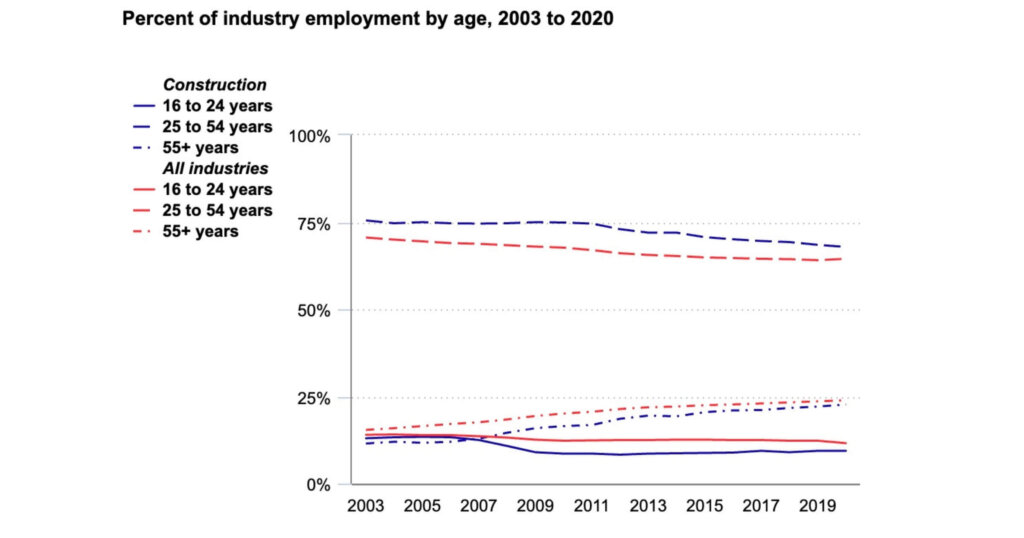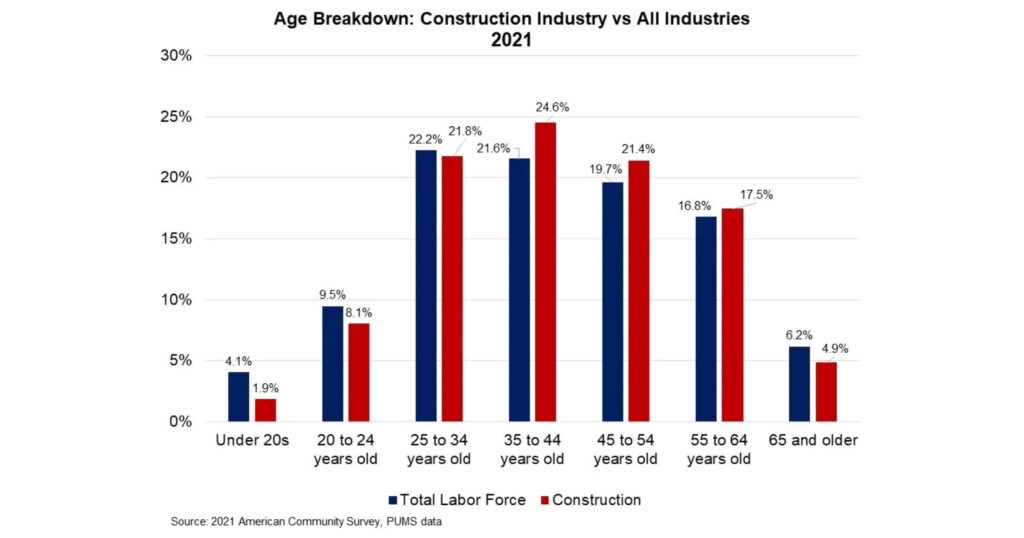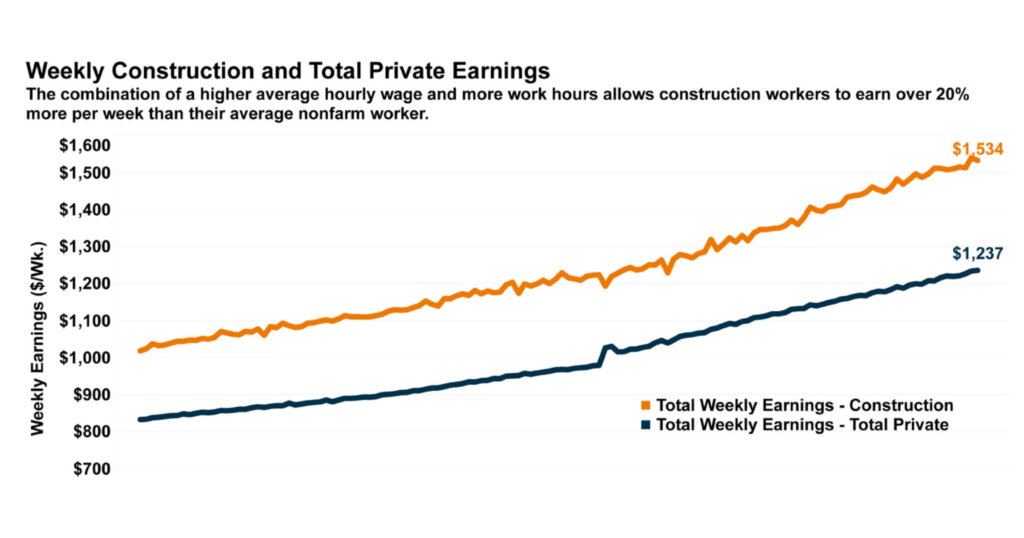Labor shortages, rising wages, and generational change are all reshaping what it means to work in construction in 2025. The skilled trades are experiencing significant shifts in both who’s doing the work and how that work is being trained, paid, and supported. This article examines eight major workforce trends currently shaping the construction industry, including an aging labor pool, the entry of Gen Z into the trades, wage inflation, and the increasing demand for sustainability skills.
Quick look
- Skilled labor shortages are intensifying as experienced tradespeople retire at a faster rate than replacements enter the field.
- Gen Z is slowly joining the trades, but employers need to modernize recruitment and training to keep them engaged.
- Changes in immigration policy are directly affecting the availability of skilled construction workers across the U.S. and Canada.
- Workforce development, green building skills, and soft skills are rising priorities across job sites and training centers.
- Human-robot collaboration is increasing, but it’s enhancing—not replacing—human labor in the construction industry.
8 labor trends to watch in construction in 2025
Trend #1: Aging workforce and talent pipeline challenges
More than 20% of the current construction workforce in North America is over the age of 55, and many are nearing retirement. This is putting severe pressure on project managers, HR teams, and trade unions to keep crews staffed and jobs on schedule. According to the U.S. Bureau of Labor Statistics, construction will need to add over 500,000 workers by the end of 2025 to keep pace with demand.
This aging-out trend is being felt across skilled trades—from millwrights and electricians to heavy equipment operators. With fewer young people entering these professions and apprenticeships not scaling fast enough, the gap continues to widen. Some companies are offering retention bonuses to older workers to encourage them to stay longer, but this is a short-term solution.
In the long term, the construction industry will need to better engage high school students, enhance vocational programs, and remove barriers for career changers. Without a more reliable talent pipeline, delays and cost overruns will become more frequent—especially on extensive infrastructure and housing projects.

Image courtesy of https://www.bls.gov/
Trend #2: Gen Z entering trades
After years of promoting four-year college degrees as the only path to success, many young people are rethinking their options. Gen Z workers—born between 1997 and 2012—are increasingly showing interest in trade careers thanks to better pay, job stability, and quicker entry into the workforce. Programs like the Skilled Trades College of Canada and NCCER’s “Build Your Future” campaign have helped reframe construction as a viable and respected career option.

In 2025, we’re seeing Gen Z fill entry-level roles in plumbing, carpentry, HVAC, and even drone surveying. But attracting and retaining this generation means understanding their values. They want mentorship, a sense of purpose, better work-life balance, and access to tech tools on the job.
Companies that ignore these cultural differences risk high turnover. Companies that prioritize clear communication, strong onboarding, and real opportunities for growth are keeping workers more engaged. If construction wants to retain the next generation, building workplaces where Gen Z feels supported isn’t a nice-to-have—it’s a must.
Trend #3: Changing immigration policy
Immigrant workers are an essential part of the construction industry in both the U.S. and Canada, particularly in major cities. But tighter border rules, shifting visa requirements, and long processing delays are making it harder for employers to bring in and keep this talent.
For example, Canada’s Temporary Foreign Worker Program (TFWP) saw significant changes in 2024, limiting the number of low-wage positions available in some sectors. Meanwhile, in the U.S., there has been political pushback on expanding work visas, such as the H-2B program, despite industry associations advocating for higher caps.
When immigration slows, labor shortages worsen, especially for roles such as concrete formers, general laborers, and framers, where training times are shorter, but turnover is high. Unionized and non-union contractors alike are feeling the squeeze.
Some provinces and states are responding with regional pilot programs or construction-specific immigration streams. Without a clear, coordinated policy in place, employers may have to lean more on creative workforce strategies and invest in training their own people to keep projects moving.
Trend #4: Investment in workforce development and apprenticeship programs
A positive this year is the surge in funding for construction training. Governments and private companies alike are investing significant resources in workforce development, particularly in areas struggling to fill skilled positions.
In the U.S., the Infrastructure Investment and Jobs Act includes billions earmarked for training and registered apprenticeships. Similarly, in Canada, provinces such as British Columbia and Alberta are expanding trade schools and offering tax credits to companies that take on apprentices.
Union halls have also joined this trend by modernizing their training facilities with simulators, BIM tools, and updated safety protocols. Employers that once hired strictly journeypersons are now building their own internal training ladders to move workers from general labor to specialized roles.
Still, the success of these programs hinges on awareness. Many young workers are unfamiliar with the apprenticeship system or assume they need a college degree to earn a good income. Promoting these pathways earlier—ideally by the time students reach Grade 10—could be a game-changer for recruitment.
Want to know which apprenticeships are worth it? Visit: The best trade apprenticeships in construction.
Trend #5: Technological adoption and human-robot collaboration
Automation in construction isn’t about replacing people; it’s about making their jobs safer and more productive. In 2025, tech like exoskeletons, bricklaying robots, robotic total stations, and autonomous earthmovers are showing up on more job sites. But they still need skilled operators and technicians to guide them.
With these tools, a small crew can pour concrete, inspect rebar, or install drywall faster and with fewer injuries. That’s especially helpful when labor is short, but training becomes even more critical. Workers need to understand both the trade and the software or device that supports it.
This shift is also creating hybrid roles: a layout carpenter might now need drone piloting skills. An HVAC tech could need to troubleshoot IoT sensors. Human-robot collaboration isn’t just for manufacturing anymore—it’s actively shaping how tradespeople do their work. Companies that offer in-house tech training or partner with tool manufacturers for upskilling are experiencing fewer delays, lower injury rates, and improved retention.
Trend #6: Rising wages and labor cost inflation
With demand high and labor supply tight, construction wages have climbed fast. Construction wages are rising across North America. For example, in Ontario, the average hourly rate reached $36.92 in 2023, which is well above the provincial average. This wage pressure is driving up project costs. Combined with materials inflation, it’s forcing general contractors to rework their bids or scale back timelines. Smaller firms, especially, are finding it tough to compete on pay alone.
To attract and keep talent, some employers are pairing pay raises with added perks like health benefits, tool allowances, or paid training. Others are experimenting with flexible hours or offering housing stipends for crews working far from home. Still, in many trades, higher wages haven’t fully closed the gap when it comes to making the work more appealing. Pay isn’t always the issue, though; burnout, job instability, and long commutes can be just as damaging to retention. Balancing wages with better working conditions is becoming a bigger priority.

Image courtesy of https://news.constructconnect.com/
Trend #7: Increased demand for green construction skills
Net-zero goals, stricter energy codes, and sustainable design requirements are changing the type of labor needed on-site. In 2025, there is a high demand for workers who understand green building practices—whether that involves passive house construction, solar panel installation, or efficient mechanical systems.
Electricians who know their way around EV charger installs, roofers skilled in green roof systems, and HVAC techs familiar with heat pumps are getting more calls from employers. Certifications like LEED and WELL are no longer just a box to tick for architects—they’re starting to influence which subcontractors make the cut.
Training programs are starting to catch up. Unions such as IBEW and UA have begun incorporating sustainability modules into their curricula. The federal government has also launched “green skills” initiatives targeting both new grads and mid-career workers. Green construction is no longer niche. It’s becoming the baseline for new builds and retrofits alike—especially in public projects.
To learn more about how sustainability is shaping the trades, visit: 10 sustainable construction technology trends to watch 2025–2027.
Trend #8: Growing role of soft skills in construction leadership
As crews become more diverse and technology plays a bigger role in the job, soft skills are receiving more attention—especially in foreperson and site supervisor roles. In 2025, leadership isn’t just about getting the job done; it’s about communication, empathy, and conflict resolution. Many tradespeople step into leadership without formal training, which can lead to friction on mixed-generation crews. Gen Z workers expect feedback and collaboration, while older workers may be used to more top-down direction.
Companies are starting to offer training in emotional intelligence, mentorship, and crew management. This isn’t just for HR reasons—it’s tied directly to productivity. Sites run by effective leaders see fewer mistakes, faster builds, and higher morale. Soft skills also matter during high-stress phases like project closeout or tight inspections. Being able to manage stress and communicate clearly under pressure is now a must-have skill, not a bonus.
Key takeaways
Construction labor is shifting fast in 2025. The workforce is aging, Gen Z is cautiously stepping in, and employers are navigating rising wages, shifting immigration rules, and a growing need for both tech fluency and sustainability skills. Companies that stick to traditional hiring and training models are falling behind.
Meeting today’s demands means rethinking how people are recruited, onboarded, and supported on the job. Technical know-how still matters, but communication, adaptability, and leadership now carry equal weight—especially as automation, green building practices, and diverse crews reshape daily work. Adjusting now isn’t optional—it’s the only way to stay competitive.
Labor isn’t the only thing changing—other shifts, like growing attention to construction waste and material efficiency, are also reshaping how projects are planned and executed.
To get more updates like this straight to your inbox, join our newsletter. Whether you’re managing a crew or considering a trade career, we have plenty of insights tailored for the jobsite.



